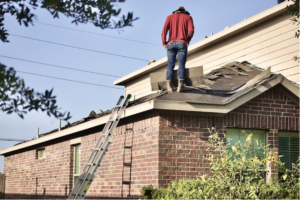A roof is one of the most critical components of any home. It is what protects you and your family from the elements, including rain, snow, hail, wind, and sun. However, like any other part of your home, your roof will eventually need to be replaced. But when exactly is the right time for a roof replacement? In this home improvement guide, we will explore the signs that indicate your roof needs replacing, how long a roof typically lasts, the different types of roofing materials available, and the steps involved in replacing a roof.
How Long Does a Roof Typically Last?
The lifespan of a roof largely depends on the type of material it is made of, as well as the quality of installation and maintenance. Here are the average lifespans of some of the most common roofing materials:
- Asphalt shingles: 20-30 years
- Metal roofing: 40-70 years
- Wood shakes: 15-30 years
- Clay tiles: 50+ years
- Slate shingles: 50+ years
It is important to note that these are only estimates, and the lifespan of your roof can vary depending on factors such as climate, ventilation, and how well it is maintained.
What Are the Signs You Might Need a New Roof?
Over time, roofs can become damaged due to wear and tear or extreme weather conditions. Some of the most common signs that you may need to use a professional service for roof replacements include damaged or missing shingles, water leaks in your attic or ceiling, and even increased energy bills. Here’s a more detailed look at the signs that indicate it’s time for a roof replacement:
Age of Your Roof
The age of your roof is one of the most significant factors in determining whether it’s time for a roof replacement. As noted above, most roofs have a lifespan of at least 20 years, depending on the type of roof and the quality of installation. Any roof that has exceeded this age should be inspected to determine whether it needs replacing. If your roof is approaching or exceeding its expected lifespan, it’s time to start thinking about a roof replacement.
Damaged Shingles
Damaged shingles are another indication that your roof needs to be replaced. Shingles that are missing, cracked, or curling at the edges indicate that your roof is no longer protecting your home adequately. If the damage is localized, you may be able to repair the affected area. However, if the damage is widespread, it’s time to replace the entire roof.
Sagging or Drooping Roof
If you notice that your roof is sagging or drooping, it’s a clear sign that it’s time for a roof replacement. A sagging roof is an indication of structural damage, which could be caused by water damage, poor installation, or other factors. If you ignore a sagging roof, it could lead to significant damage to your home’s interior, including mold and water damage.
Leaks and Water Damage
If you notice water stains on your ceilings or walls, it’s a clear indication that your roof is leaking. Roof leaks can be caused by a variety of factors, including damaged shingles, poor installation, and age. If you ignore a roof leak, it can lead to significant damage to your home’s interior and even compromise the structural integrity of your home.
Increased Energy Bills
If you’ve noticed a significant increase in your energy bills, it could be a sign that your roof needs to be replaced. A poorly insulated or damaged roof can allow air to escape from your home, leading to increased energy bills. A new roof with proper insulation will help keep your home’s temperature consistent, resulting in lower energy bills. So if you’re noticing unusually high energy bills, it’s time to consider a roof replacement.
These are just a few of the signs that indicate your roof needs replacing. If you notice any of these issues with your roof, it’s best to consult a professional for an inspection and advice on the best course of action.
How to Choose Between Replacing And Repairing The Roof?
When deciding whether to repair or replace your roof, there are several factors to consider. First, you’ll need to assess the extent of the damage. If the damage is localized, it may be possible to repair the area without replacing the entire roof. However, if the damage is widespread or severe enough that it’s compromising your home’s structural integrity, then a full roof replacement will likely be necessary.
Next, you’ll want to factor in cost. It may be more cost-effective in some cases to simply replace an old and damaged roof than pay for frequent repairs. You should also consider how long you plan on staying in your current residence when deciding between repairing and replacing your roof. Replacing a roof can be costly, so if you don’t plan on staying in your home for much longer, then a repair may be the more cost-effective option.
Finally, you’ll need to consider the condition of the rest of your roof. If your roof is significantly damaged or nearing its expected lifespan, it’s best to replace it rather than repair it. This will ensure that your home is adequately protected from the elements and reduce the risk of future damage due to leaks or other problems.
Consult With Professional Roofers
When it comes to replacing or repairing your roof, the best course of action is always to consult with professional roofers. Professional roofers have the experience and expertise necessary to assess the condition of your roof and make recommendations on whether to repair or replace it. They can also provide valuable advice on how best to maintain your existing roof to prolong its lifespan. Furthermore, they can help you find reliable materials for a new installation that is suitable for your home’s climate and budget. But before you hire any contractor, there are a few important things you should consider when selecting the right professional for the job.
First, it’s important to do your due diligence and research any roofing company you’re considering. Look for reviews from past customers, read up on the company’s background, and make sure they are properly licensed and insured. You should also get several quotes from different contractors before deciding which one to hire. This will help ensure that you get the best value for your money. Finally, don’t be afraid to ask questions! Professional roofers should be willing to answer any questions or concerns you have about their services or materials used in a new installation. It’s better to ask these questions upfront than find yourself with unexpected costs down the line.
Hopefully, this guide has given you a better understanding of when it’s time to replace or repair your roof. Remember, a well-maintained and properly installed roof is essential for protecting your home from the elements and preserving its value over the long term. So if you notice any signs of damage or distress, don’t hesitate to contact a professional right away. They can help ensure that your home remains safe and secure for years to come!


